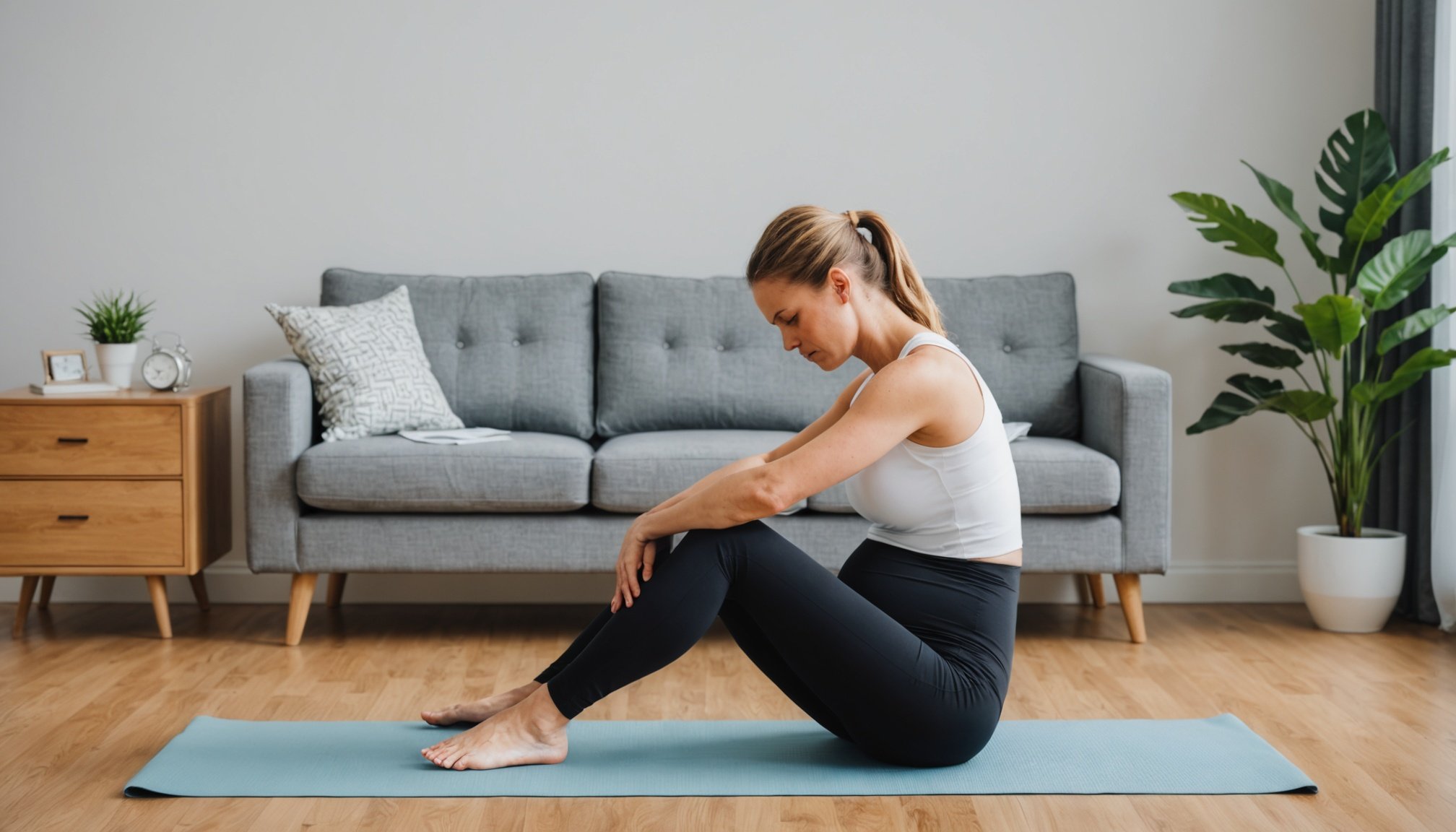Top Recommended Exercises to Alleviate Leg Cramps During Pregnancy in the UK
Understanding Leg Cramps During Pregnancy
Leg cramps, often referred to as nocturnal leg cramps, are a common complaint among pregnant women. These sudden, sharp pains in the legs can be quite distressing, especially when they occur at night and disrupt sleep. To understand why these cramps happen, it’s essential to look at the physiological changes that occur during pregnancy.
During pregnancy, the body undergoes significant changes, including the expansion of the uterus, hormonal shifts, and increased blood volume. These changes can lead to various symptoms, including leg cramps. Here are some of the key causes:
Topic to read : Discover the Latest UK Innovations for At-Home Fetal Heart Rate Monitoring
- Pressure on Nerves: As the baby grows, it can put pressure on the nerves in the pelvis and legs, leading to pain and cramping.
- Hormonal Changes: The hormone relaxin, which is released during pregnancy, can cause ligaments to loosen, leading to instability and potential pain in the muscles and joints.
- Fluid Retention: Pregnancy often involves fluid retention, which can lead to swelling in the legs and feet, contributing to muscle cramps.
Exercises to Strengthen and Relax Muscles
While leg cramps can be uncomfortable, there are several exercises that can help alleviate them. Here are some of the top recommended exercises:
Prenatal Yoga and Swimming
Practicing prenatal yoga or swimming can be highly beneficial. These activities help strengthen and relax the pelvic muscles, which can reduce the frequency and severity of leg cramps.
In parallel : Empowering UK Women: Effective Strategies to Conquer the Fear of Childbirth
- Prenatal Yoga: Yoga can help improve flexibility, balance, and strength. Specific poses like the “cat stretch” and “pelvic tilts” can strengthen the lower back and pelvis, reducing the likelihood of leg cramps.
- Swimming: Swimming is a low-impact exercise that can help improve circulation and reduce muscle tension without putting excessive strain on the joints.
Pilates
Pilates is another excellent form of exercise for pregnant women. Here are some Pilates exercises that can help:
-
Pelvic Floor Muscle Exercise: This exercise strengthens the pelvic floor muscles, which can help stabilize the pelvis and reduce pain in the legs.
-
Sit on your knees with legs together and butt on the heels, or lie down with your head elevated and knees bent.
-
Imagine trying to control the urge to urinate; you will feel the muscles squeeze.
-
Hold for ten seconds, then relax gradually. Repeat ten times.
-
Pelvic Tilts: This exercise strengthens the lower back and pelvis.
-
Lie on your back with the head and shoulders elevated on a pillow, and knees bent. Breathe in gently.
-
While breathing out, press your lower back down using the abdominal muscles. Your pelvis tilts, and the tailbone rises gently.
-
Hold for about five to ten seconds. Repeat five to ten times.
-
Wagging the Tail: This exercise improves flexibility, stability, and strengthens the lower back and abs.
-
Start on all fours and keep your wrists aligned to the shoulders.
-
Suck in your belly, lift one knee, and make circular movements with the leg.
-
Repeat the same with another leg. Repeat three to four times.
Kinesio Taping for Support
Kinesio taping is a non-invasive method that can provide additional support and relief from leg cramps and other pregnancy-related discomforts.
How Kinesio Tape Works
Kinesio tape works by microscopically lifting the top layer of skin to encourage better blood flow, reduce swelling, and facilitate lymphatic drainage. When applied correctly, it can provide immediate relief that can last up to 3-5 days.
Applying Kinesio Tape for Leg Cramps
-
Lymphatic Taping: For swelling in the legs and feet, kinesio taping can be applied to help with lymphatic drainage.
-
Apply the anchor end of the tape close to the lymphatic drainage ducts, with strips of tape extending along the nearby lymphatic channels.
-
The tape is applied with a light stretch, lifting the skin just enough to relieve pressure on the lymphatic vessels and allowing them to drain excess fluid more efficiently.
-
Supportive Taping: Kinesio tape can also be used to provide extra stability to the joints and muscles in the legs.
-
Apply the tape around the affected area to provide support and reduce muscle tension.
Additional Tips to Help Alleviate Leg Cramps
Here are some additional tips that can help reduce the occurrence and severity of leg cramps during pregnancy:
Stretching and Warm Baths
-
Stretching: Regular stretching can help relax the muscles and improve circulation. Focus on stretching the calf and hamstring muscles, as these are common areas where cramps occur.
-
Stand facing a wall with one hand on the wall for balance.
-
Step one foot back about a foot and a half, keeping your heel on the ground.
-
Bend the front knee and lean forward, stretching the back leg. Hold for 15-30 seconds and repeat on the other side.
-
Warm Baths: Taking a warm bath before bed can help relax the muscles and reduce the likelihood of cramps.
-
Add some Epsom salt to the bath for extra relaxation benefits.
Comfortable Sleep and Hydration
-
Comfortable Sleep: Ensure you are getting a good night’s sleep by maintaining a comfortable sleeping position.
-
Use a pillow between your legs to reduce pressure on the hips and pelvis.
-
Avoid lying flat on your back, especially in the later stages of pregnancy, as this can decrease blood supply to the fetus.
-
Hydration: Staying hydrated is crucial to prevent muscle cramps.
-
Drink plenty of water throughout the day, especially in the evening before bed.
Practical Insights and Actionable Advice
Here are some practical insights and actionable advice to help you manage leg cramps during pregnancy:
When to Seek Medical Help
While leg cramps are common, it’s important to know when to seek medical help.
- Persistent or Severe Pain: If you experience persistent or severe pain, it’s best to contact your doctor or midwife immediately.
- They can help identify the cause of the pain and provide personalized advice and remedies to alleviate the discomfort.
Monitoring Your Health
Regular monitoring of your health is crucial during pregnancy.
- Keep a Symptom Journal: Keeping a journal of your symptoms can help you track when leg cramps occur and what might trigger them.
- This information can be valuable when discussing your symptoms with your healthcare provider.
Staying Active Safely
Staying active during pregnancy is important, but it’s crucial to do so safely.
- Consult Your Healthcare Provider: Before starting any new exercise routine, consult your healthcare provider to ensure it is safe for you.
- They can provide guidance on exercises that are suitable for your stage of pregnancy and any health conditions you may have.
Table: Comparison of Exercises for Leg Cramps During Pregnancy
| Exercise | Benefits | How to Perform | Precautions |
|---|---|---|---|
| Prenatal Yoga | Improves flexibility, balance, and strength. Reduces muscle tension. | Practice specific poses like “cat stretch” and “pelvic tilts”. | Avoid deep stretches and face-down positions, especially in later trimesters. |
| Swimming | Low-impact exercise that improves circulation and reduces muscle tension. | Swim laps or participate in water aerobics. | Ensure the water is not too cold or too hot. Avoid swimming if you have any medical conditions that may be exacerbated by water activities. |
| Pilates | Strengthens pelvic floor muscles, improves stability in the hip, pelvis, and lower back. | Perform exercises like pelvic floor muscle exercises, pelvic tilts, and “wagging the tail”. | Avoid lying flat on the back, especially in later stages of pregnancy. Consult a physical trainer for safe modifications. |
| Kinesio Taping | Provides support, reduces swelling, and facilitates lymphatic drainage. | Apply tape to lymphatic channels or around affected areas for support. | Ensure the tape is applied correctly to avoid skin irritation. Consult a healthcare provider if you have sensitive skin. |
| Stretching | Relaxes muscles and improves circulation. | Stretch calf and hamstring muscles regularly. | Avoid overstretching, especially if you have any underlying muscle or joint issues. |
Quotes and Real-Life Examples
Here are some quotes and real-life examples that highlight the importance and effectiveness of these exercises:
-
“You can perform many reformer exercises through pregnancy, specifically those on hands and knees, kneeling, side-lying, and standing. Lying supine may decrease blood supply to the fetus during the second and third trimester.” – Williams, emphasizing the importance of safe exercise modifications during pregnancy.
-
“I started running with the buggy when my children were six months. It was a revelation. It gave me back a lot more freedom to run and to meet running friends as I didn’t need childcare.” – Waterlow, sharing her experience of returning to running postpartum and the benefits of incorporating family-friendly activities.
Leg cramps during pregnancy can be a significant source of discomfort, but they are not inevitable. By incorporating the right exercises, such as prenatal yoga, swimming, Pilates, and kinesio taping, you can significantly reduce their occurrence and severity. Remember to stay hydrated, maintain a comfortable sleep position, and consult your healthcare provider before starting any new exercise routine.
Pregnancy is a journey filled with its share of challenges, but with the right information and support, you can navigate these challenges more comfortably. Always prioritize your health and the health of your baby, and don’t hesitate to seek medical advice if you have any concerns.
By staying active, practicing safe exercises, and using supportive methods like kinesio taping, you can help ensure a healthier and more comfortable pregnancy. Remember, every pregnancy is unique, so it’s essential to tailor your approach to your individual needs and health status. With the right strategies, you can alleviate leg cramps and enjoy a more comfortable pregnancy journey.











